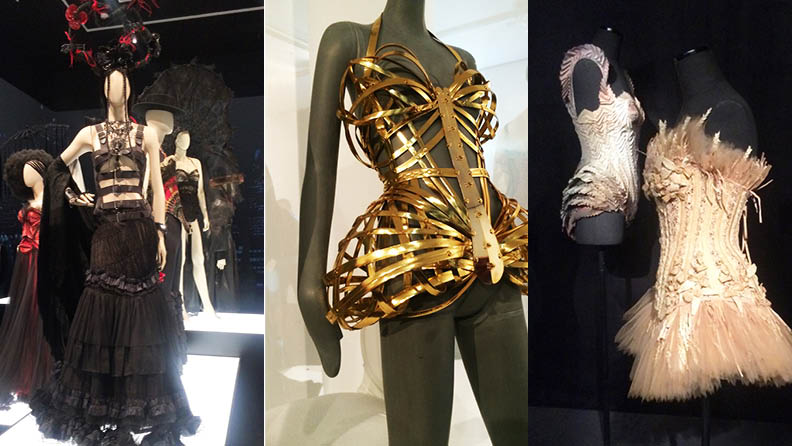
The world of Jean Paul Gaultier is one without boundaries. It’s sexy and witty, blending high and low culture, using materials in unpredictable ways to graft together unique statements, often about gender and sexuality. This is a designer who says “why not?”; who approaches his work exuberance and zest, and uses his creative energy to question, provoke, and make people laugh.
The Fashion World of Jean Paul Gaultier: From the Sidewalk to the Catwalk has been on display at the National Gallery of Victoria since October, and there’s now just a sliver of time left to catch a glimpse before it closes on February 8. And if you haven’t been down there yet, I really think you should.
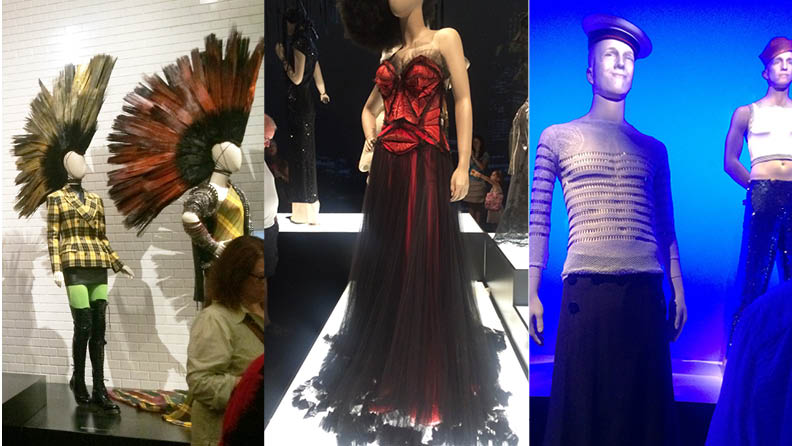
Even a quick glance around the exhibition space should quell any questions about whether fashion belongs in an art gallery. Gaultier’s craftsmanship is exquisite – from glistening mermaid gowns that pool to the floor with effortlessly liquid construction, to a long skirt with mariner stripes made entirely out of tiny feathers, to a striking ‘leopard print’ gown, embroidered with thousands of tiny glass beads, which reportedly took over 1000 hours to create. The sheer theatricality of Gaultier’s runway shows is highlighted through the use of 32 beguiling, custom-designed mannequins, with faces video projected onto them so that they wink, look around, nod knowingly at you, speak and even sing in eerie chorus.
But along with his incredible artistry and vibrant sense of showmanship, Gaultier’s work matters because of the ideas he plays with; the way he uses design to deconstruct conventions, particularly about gender and sexuality. He’s a terrible provocateur, but it’s done with exuberance rather than barb. In a notable point of difference to many other edgy, contemporary designers – like, say, Alexander McQueen, who always wanted to shock and offend – Gaultier brings a healthy dose of humour and joie de vivre to his work. And that makes it pretty fun.
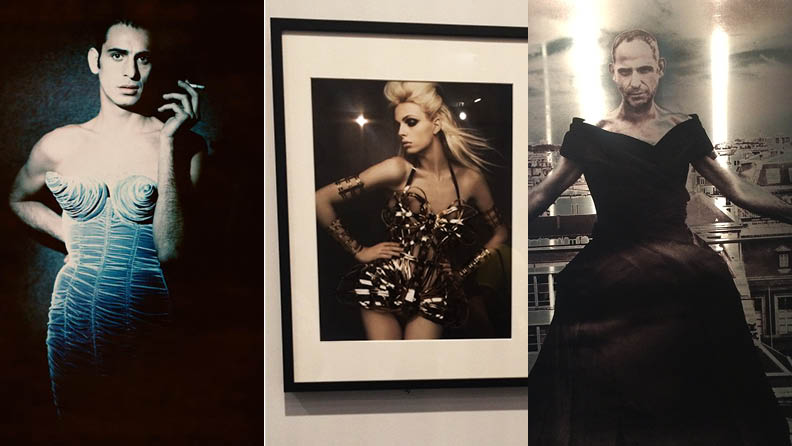
The fluidity of gender
For Gaultier, the boundaries between men and women’s clothing are mere suggestions, and suggestions are meant to be ignored. This idea was neatly encapsulated as early as his spring/summer 1985 collection, A Wardrobe For Two, where he put men with flowing hair in skirts and women in dapper tailoring – in other words, androgyny before it was cool.
No moment expressed this more clearly than when he cast the iridescent transgender Australian model Andreja Pejic as a bride in his spring/summer 2011 couture show. At the time, Andreja was known as Andrej, a 19-year-old boy from Melbourne just beginning to make a name as an androgynous male model. Gaultier was one of the first major designers to take notice of her and swiftly became besotted, describing her variously as “genius” and a “modern woman-boy of today.” In many ways, it was Gaultier’s joyful obsession with Pejic that paved the way for her whirlwind success. Having her walk the runway in a bridal gown marked an iconic moment in fashion history, a distinct part of a movement towards gender fluidity in fashion.
As part of this penchant for gender blending, traditional ideas of masculinity are necessarily challenged. Gaultier’s men are joyfully feminised, and sexualised in a way that is usually applied only to women. He turns the male gaze – and the female gaze – onto men (just as women are looked at by men and women), dressing them as camped-up sailors in his signature Breton stripes and flowing skirts.
Obviously, men in skirts is very de rigueur in high end fashion these days, but Gaultier was one of the first to do it back in the early 80s – and in those days, it was a big deal. The first time he showed skirts in a men’s collection, the staff of Vogue, French Elle and Marie Claire all walked out of his show. Unperturbed, he took it further, even putting men in corsets, and he was the first high-end designer to release a makeup collection for men.
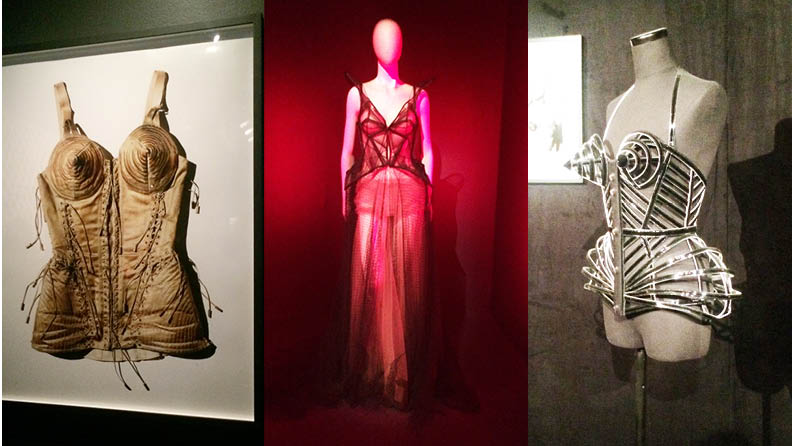
The sensuality of the female form
When Gaultier met Madonna in 1987, it was a pivotal moment in both their careers – and in fashion history. It’s impossible now to separate the name Gaultier from the image of the famous cone bra and elaborate corsetry he designed for Madonna’s 1990 Blond Ambition World Tour. Nobody had done underwear as outerwear quite to that extent before, and the exaggerated hourglass curves of the female body became a motif throughout his work, immortalised particularly in his iconic Classique perfume bottle. The image of Madonna onstage in a cone-shaped bra paired with men’s suit trousers with strategic slashes is one of the most enduring of the era; the Blond Ambition Tour was banned in many venues across the globe for its highly provocative, religiously-charged displays of sexuality, and Gaultier’s reputation as fashion’s favourite enfant terrible was cemented.
For Gaultier, the dramatic curves of the corset are representative of the power of female sexuality. As a child, Gaultier was mesmerised by his grandmother’s corsets and what he saw as the wonderful theatricality of women’s dress. The first cone bras he designed weren’t for Madonna, but much earlier, for his teddy bear, Nana (who is on proud, though disheveled, display in a glass cabinet in the exhibition.) “For me, the corset evoked something extraordinary, fascinating and mysterious,” he says. “When I started designing, young women had begun to reassert their femininity. They were reinventing the idea of the female sex object, who became strong and free enough to play with the rules. It was Madonna who came to perfectly embody this type of woman.”
Of course, not everyone would agree that the corset is an empowering garment, but it’s clear that Gaultier’s intention is to celebrate the female body, not repress it. Female sexuality continues to be a potent theme throughout his work, and many of his designs referencing the sensuality of the flesh and bodily forms in similar ways, through the use of expert construction and sumptuous materials.
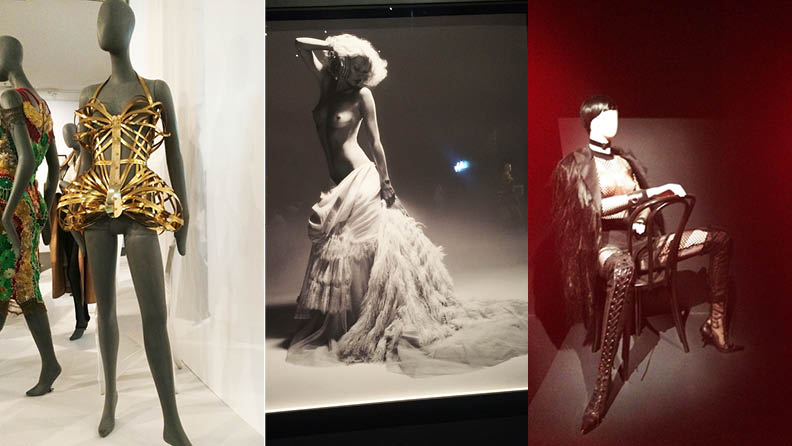
Beauty is in diversity
One of the most common critiques of the fashion industry is that it generally celebrates only a very narrow definition of beauty. Runways are filled with tall, white, androgynous wisps of girls – girls with an otherworldly delicacy, to whom only a small fraction of real-world women surely feel much resemblance. But Gaultier has always been bored by this kind of same-sameness, finding it dull and uninspiring. Instead, he seeks out models and muses with strong personalities and unique kinds of beauty – people who really capture his imagination. “To show just one type of girl is a defect – which is the thing I’m always fighting,” he told i-D. “One kind of beauty – NO. I want all types of beauty because I love difference.”
A trademark of his shows is the use of unconventional models, girls of all different ages, ethnicities, shapes and sizes – and often those who are heavily tattooed or pierced. Along with Andreja Pejic, his menagerie of muses has included Sudanese model Alek Wek, Spanish actress Rossy de Palma (who with her sharp, unusual features has been described as “a Picasso come to life”), model Eve Salvail (perhaps the only model to dare to shave her head and flaunt a tattooed skull) and Carmen Dell’Orefice, who at 83, is renowned as fashion’s oldest working model.
He has presented collections inspired by complex anti-beauties like Frida Kahlo and Amy Winehouse, paying delighted homage to their dark, dreamy and eccentric looks. And in a major act of fashion rebellion, he has even put ‘plus-sized’ models on the catwalk, with size 16 Crystal Renn a favourite of his, and Beth Ditto from The Gossip opening his spring/summer ’11 show in a soft chiffon corset decorated with flowers.
And why not? This is a designer after all, who was inspired to create an African tribal-style cuff bracelet while opening a can of food for his cat; who once sent live turkeys as Christmas gifts to fashion’s most influential editors because he thought they were beautiful and he liked the way they naturally strutted like models. He once made a dress out of bread. In the world of Gaultier, beauty is everywhere.